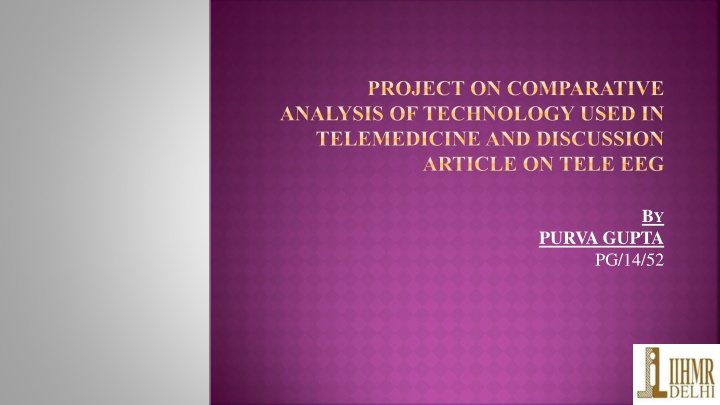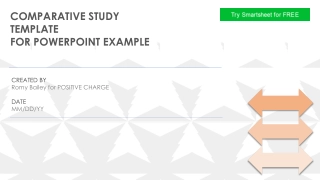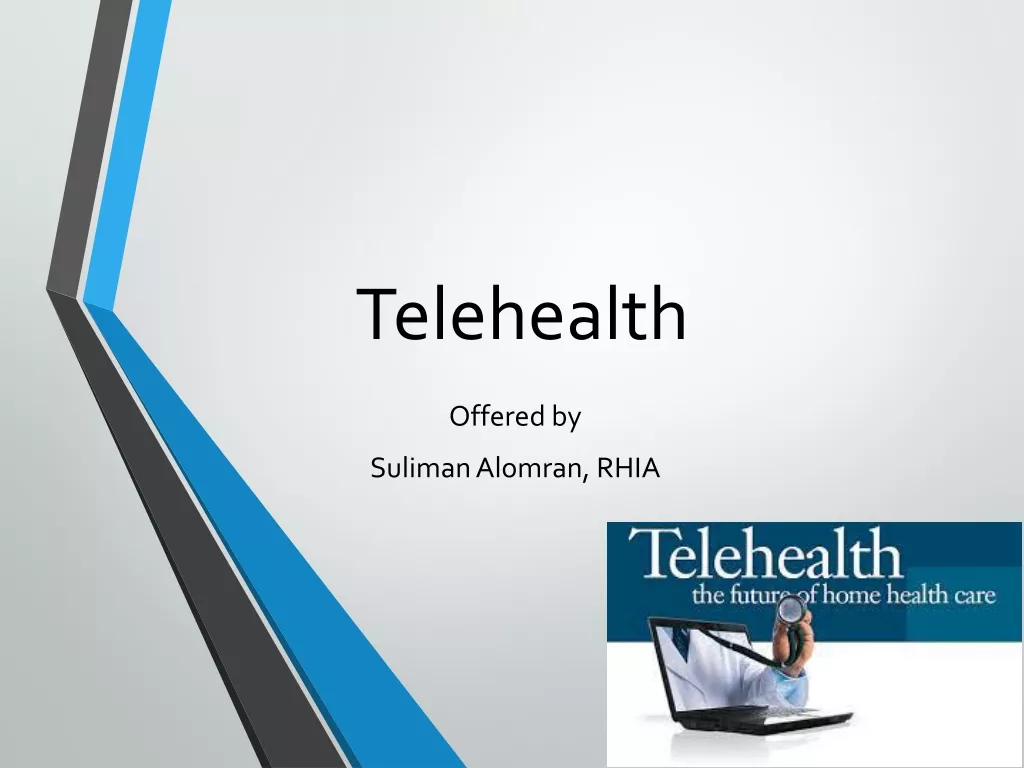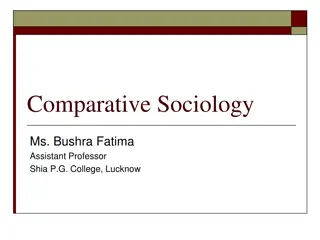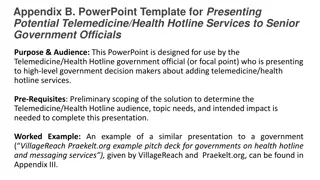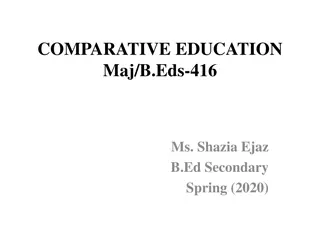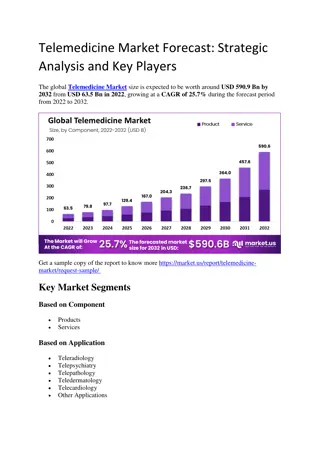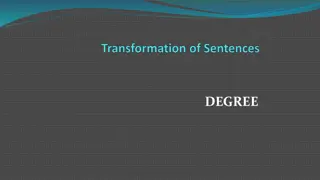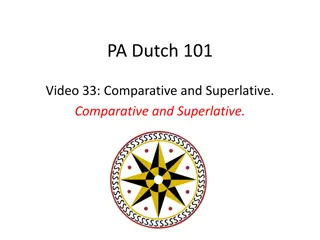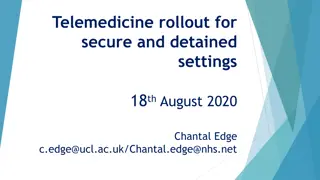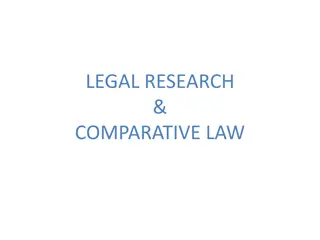Comparative Analysis of Telemedicine Technology
eTelemedicine utilizes computers and telecommunication technologies to provide medical services from distant locations, addressing the shortage of healthcare providers in rural areas. Explore the impact of telemedicine on patient accessibility, engagement, and outcomes, along with the opportunities it offers for value-based care and preventive medicine.
Download Presentation

Please find below an Image/Link to download the presentation.
The content on the website is provided AS IS for your information and personal use only. It may not be sold, licensed, or shared on other websites without obtaining consent from the author.If you encounter any issues during the download, it is possible that the publisher has removed the file from their server.
You are allowed to download the files provided on this website for personal or commercial use, subject to the condition that they are used lawfully. All files are the property of their respective owners.
The content on the website is provided AS IS for your information and personal use only. It may not be sold, licensed, or shared on other websites without obtaining consent from the author.
E N D
Presentation Transcript
PROJECT ON COMPARATIVE ANALYSIS OF TECHNOLOGY USED IN TELEMEDICINE AND DISCUSSION ARTICLE ON TELE EEG BY PURVA GUPTA PG/14/52
INTRODUCTION eTelemedicine may be defined as the use of computers and telecommunication technologies to provide medical information and services from distant locations. Telemedicine (Tele = Distance ~ Medicine) is a concept of providing healthcare to the patient instead of him travelling to unknown and strange places at enormous cost. inIt may be as simple as two health professionals discussing a case over the telephone, or as sophisticated as using satellite technology to broadcast a consultation between providers at facilities in two countries, using videoconferencing equipment. formation quantify with Likert scale and sefor frequency table to review the response in each category of the STEPS criteria.
PROBLEM STATEMENT As there is the shortage of Healthcare providers in rural areas, which had led to lack of accessibility to both basic healthcare and speciality care, the concept of telemedicine was introduced. Through telemedicine, patients can to get access to healthcare faster, which is a leading factor in improved patient engagement and better outcomes. As the healthcare industry is being driven towards value-based care, the use of telehealth technologies results in many positive outcomes including: fewer hospital re-admissions, more faithful following of prescribed courses of treatment, and faster recovery than that of patients not receiving remote intervention. Telemedicine allows hospitals to create hub-and-spoke networks to provide each other with support. By easily sharing their expertise outside their own institutions, doctors can offer incredible value to their medical colleagues and those colleagues patients. Remote medical technology is an increasingly effective way to administer preventive medicine and manage chronic conditions. Distance should not be a barrier, to access quality healthcare services, telemedicine came into role.
REVIEW OF LITERATURE mall. Antoniotti NM. Current trends and opportunities in TeleHealth: The Jetsons have arrived! Region 4 Genetics Collaborative Regional Meeting. May 3, 2005, Lansing, MI. TeleHealth is a tool for access. Can be asynchronous (store and forward) or synchronous (interactive). Technology needed includes: patient exam camera, digital electronic stethoscope, fiber-optic otoscope, fiber-optic opththalmoscope, digital camera, document camera, intra-oral camera, laser caries detector, clinical video (Polycom, Vcom), and clinical exam rooms. In regards to transmission spectrum, you need to have good quality (ISDN and LAN) while maintaining secure lines. Maritime Medical Genetics Service (MMGS) serves about 2 million people . Future directions of telemedicine include more investigation of reimbursement, transmission costs, financial state of federal and state budgets, interoperability, new compression algorithms, asynchronous patient driven consultations, and internet medicine.
EHersh et al. (2001a) focused on 28 studies of pediatric and obstetric telemedicine and home-based telemedicine. For store-and-forward telemedicine, they find some evidence of comparable diagnosis and management decisions in the areas of pediatric dental screening, pediatric ophthalmology, and neonatology. For self-monitoring/testing telemedicine, they find improved access to care in the areas of pediatrics, obstetrics, and clinician-indirect home telemedicine. Access is particularly enhanced when the telehealth system enables timely communication between patients or families and care providers that allows self- management and necessary adjustments that may prevent hospitalization. There is some evidence that this form of telemedicine improves health outcomes, but the study sample sizes are usually small, and even when they are not, the treatment effects are small. act analysing the costs uperioCommunication
METHODOLOGY STUDY DESIGN The study was non experimental evidence based in nature. The study was based on observation made. It broadly included: Present status of the telemedicine department ( Through collection of primary data and Secondary Data from the organization). Comparison of Manpower for the organization. Designing comparision matrix. DATA COLLECTION TOOLS Interview and discussions with head of the departments. Checklists Observation. Using available information Telemedicine tool kit Telemedicine guidelines. STUDY TIME Study time was of 2 months 10 days which included Review of guidelines, collecting data, compiling data, review of secondary data, Comparitive Analysis analysis and final report compilation.
EPSSTUDY METHODOLOGY The study includes the situational analysis through identification of gaps in technology used in telemedicine through comparitive analysis (Interviews, Observations, Secondary data review, Telemedicine Toolkit) as mentioned and discussed. As per the result scoring was done on a scale of 1 to 5 . Scoring was done to measure the scope of improvement. STUDY DATA Primary data:- To study the present status and functioning of department of Telemedicine . Secondary data: - Records of various departments. Present status of the department. Comparison with Neurosynaptic communication.. Comparison/ compliance with Telemedicine Standards.
COMPARITIVE ANALYSIS OF VHealth 365 ( A PLATFORM OF TRS SOLUTIONS) WITH NEUROSYNAPTIC COMMUNICATION: FEATURES TELERADIOLOGY SOLUTIONS NEUROSYNAPTIC COMMUNICATION PRODUCT COMPARISION MATRIX ( SCALE 1 TO 5) 4 Bandwidth 1 mbps 32 kbps 3 Telemedicine platform V Health 365 ReMeDi 4 4 System Highlights Not integrated with HMIS Integrated with HMIS 3 4 Means of consultation On demand video consultation .NET On demand consultation 5 4 Workflow No information 5 - Audio/Video Web RTC No information 5 - Means of Installation No installation No installation 5 5 Technology STUN and TURN No information 5 - Technology Cloud based Cloud based 5 5 Marketing B to C Marketing No information. 5 - Data protection SSL encrypted No information 5 - User friendly system User friendly Comprehensive and User friendly EMR 4 4
TECHNOLOGY USED : FEATURES AVAILABLE .NET High definition Web RTC 1.0 video technology 1 Mbps download/upload SSL encrypted V Health 365 High end devices TSP VARIOUS PARAMETERS Workflow Audio/video Bandwidth Data protection Telemedicine platform Data rate Service provider
vidWEB- RTC Web RTC ( Web Real Time Communication) is a common standard developed by the W3C in close cooperation with the Web RTC standard developed by the IETF. Web RTC functions at a lower protocol layer, Web RTC enables the embedding of this functionality in applications and websites. The protocol is commonly used to support voice or video chat between peers. With Web RTC adaptation quickly across the digital landscape, well supported communication technology standard that makes high definition, high resolution, low bandwidth video, peer to peer data transfer and audio chat easily accessible. Web RTC patients and clinicians no longer be required to install a browser plug in while using Chrome, Firefox or Opera. The peer to peer nature of Web RTC makes this technology the only solution that can provide the scalability and technology neutrality , the healthcare industry will require in order to further the efforts of data interoperability. nce based
Stake holders of the government sponsored national level health insurance schemes are satisfied with IT enabled process of the enrolmenV- HEALTH 365 V- Health 365 is a exclusive telemedicine hubspot. It is a telemedicine platform which enables greater access to healthcare for patients without having to visit a clinic or hospital. It is a telehealth platform that delivers a comprehensive and efficient solutions to the healthcare providers seeking to manage the workflow. Using vhealth 365 platform, Healthcare providers can conduct on demand virtual consultations to reduce avoidable visits to the emergency departments, schedule and conduct follow up consultations for patients with chronic conditions or those undergoing active treatment and provide remote medical services such as occupational health and in school virtual clinics. Various telemedicine hubs are set up in Apartment Complexes, Gated Communities, Corporate Parks, Corporate Clinics etc. Primary care consultations and second options can be availed on mobile or computer without having to take a day off or waste time in travelling and waiting at the clinic,th scheme made available operational through IT enablement of processes, though vast difference in response noted from providers between private/government.
STEPS OF DESIGNING AND IMPLEMENTING A TM PROGRAMME: STEP 1 : CONVENE THE TELEMEDICINE TEAM. (Includes Project Manager, Medical Staff Rep, IT, Financial Officer, HR ,Legal Rep, Quality Improvement Rep, Consumer Advocate, Community Health Leaders). STEP 1 -CONDUCT MARKET ASSESMENT STEP 2- CONDUCT A SELF ASSESMENT STEP 2: IDENTIFY COMMUNITY NEEDS. STEP 3-ALLIGN GOALS WITH THE ORGANIZATION MISSION STEP 4-DEVELOP A TIMELINE FOR IMPLEMENTATION STEP 3: ASSESS EXISTING COMMUNITY RESOURCES ( Facility, Technology, Staff, Developing Financial Plans.) STEP 5-GAIN ADMINISTRATIVE SUPPORT STEP 4: IDENTIFY PROGRAM EXPENSES. STEP 6- TRAIN PROVIDERS STEP 5: IMPLEMENTING AND EVALUATE THE PROGRAM. STEP 7- START SIMPLE AND FINALLY INTEGRATE TM WITH OTHER SYSTEM.
STAKEHOLDER ANALYSIS : Description Project Stakeholder Assigning of the project and providing guidance all throughout the work. Chief Executive Officer Project Manager Execution of the project, Guided about project management tactice, prepre the project charter, GANTT Chart, PERT Chart,WBS, Prepare Project charter. Guided about the Telemedicine , its platform (v health 365), Workflow. Project Assistance Hiring requirement, Training, Brief introduction about the organization. Human Resource Technology used in telemedicine, its workflow with practical live. IT department Marketing tactics. Sales department Developing the telemedicine platform, and resolving issues related to it. Developer: Examining the patients by telemedicine. Medical co-ordinator, Doctors and Physicians Give feedback. End users
PROJECT CHARTER : Project Title: Study about telemedicine and comparative analysis of at Key Success Factor Person Approving Teleradiology Solutions. Successful. Got new creative ideas of telemedicine. Project Teleradiology Solutions, Dr. Sunita Sponsor: Whitefield, Bangalore Maheshwari Date Prepared: March, 2016 . (CEO of Teleradiology Solutions) 9th Mr. Harish T. S. Project Manager: Project Teleradiology clients. Customer: Study about telemedicine platform used in Telerad, its workflow and challenges, to provide cost effective and instant better healthcare services to rural areas. Stakeholder Analysis, Comparative analysis of technology of telemedicine. Project Acceptance Criteria: Purpose: Project Description: The telemedicine project Project Manager Authority Level aims to give more user friendly services a. Staffing Decisions: Yes b. Budget Management and Variance: to the customer. It will be technology leverage between the doctor and the patients. It is helpful to understand various technology and creativity in telemedicine to provide better healthcare services in rural areas. Yes c. Technical Decision: Yes - d. Conflict resolution: Yes e. Escalation Path for Authority
Project Requirement: Internal Escalation External Escalation Stakeholder listing, service provider, matching of the technology, security, Government and Ethical approval. Executive Project Manager Administration Team leader Account Executive Account manager Project manager Team leader Summary of Budget: Not disclose Approvals Project Manager Initial Risk: Cost of the application service, bandwidth Compatibility: With users device, network
REQUIREMENT DOCUMENT : Acceptance Stakeholder Requirement Category Priority Criteria Chief Executive I : Key Player Success of Project I High, High Officer High influence Project Manager Manage Project I High, High power and high Project Telemedicine workflow and platform. interest in III High, High Assistance project. II: Meet their Finance & Accounts Cost Benefit II High, Low Department needs IT department Technology guidance I High,,High High influence power and low Sales Department Manage Project IV Low, High interest Marketing Team Launch IV Low, High III: Least Devolper Dev. TM platform and resolves issues. I High, High important IT department Support II High, Low Low influence Medical co-ordinator Diagnosis and treatment. I High, High and low interest IV: Show Doctors Diagnosis the patient using TM technology. I High, High consideration Physicians Diagnosis I High, High Low influence Operation owner Accessibility III Low, Low and high interest in project. End users User friendly III Low, Low
TECHNOLOGIES OF TM DISCOVERED ABROAD: DISCOVERED AT NAME OF THE TECHNOLOGY DISCOVERED FOR TELEMEDICINE MEDiSN John Hopskin University, MASN Rochester Institute of Technology, USA Code Blue Harvard University Sensor Lab AlarmNet University of Virginia University of Wisconsin, Medison, USA MobiCare
MEDISN MEDiSN was designed at John Hopskin University, especially for patients monitoring in hospital and during disaster events. It consists of multiple Physiological Monitors (PMs) which are battery-powered motes that are equipped with sensors for measuring patients physiological data such as ECG, pulse rate, blood oxygen level etc. PMs temporarily store collected measurements and transmit them after encrypting and signing them. MEDiSN architecture incorporates distinct Relay Points (RPs) which self organize into bidirectional wireless trees connecting the PMs to one or more Gateways. Traffic flowing in both directions is protected using hop-by-hop retransmissions that counter the effects of packet collisions and corruptions. PMs can be mobile while the RPs are stationary in fixed positions. RPs can use the electricity grid in hospital deployments, while in disaster events batteries can power RPs for multiple days.
MASN The robust Medical Ad hoc Sensor Network (MASN) is a practical hardware and software platform developed at Rochester Institute of Technology, USA. It was designed to perform real-time collection of medical data. MASN adopts a reliable cluster-based communication scheme as its routing protocol for transmitting data. MASN consists of large amount of wireless ECG communication units. Each unit is called a mobile platform . These mobile platforms are essentially the wearable ECG devices that would be placed on the patients in order to offer continuous monitoring of the patients vital signs .
CODE BLUE CodeBlue is a research project on medical sensor network developed at the Harvard University Sensor Lab. In this architecture, medical sensors are placed on the patient s body to sense medical data and transmit it wirelessly to the medical care givers for further analysis. It is based on a publish/subscribe routing framework, allowing multiple sensor devices to relay data to all receivers that have registered an interest in that data. This communication model fits naturally with the needs of medical applications where a number of caregivers may be interested in sensor data from overlapping groups of patients.
ALARMNET A Wireless sensor networks for assisted-living and residential monitoring was developed at the University of Virginia, integrates environmental and physiological sensors in a scalable, heterogeneous architecture. A query protocol allows real-time collection and processing of sensor data by user interfaces and back-end analysis programs.
MOBICARE MobiCare is a remote wireless patient monitoring system designed at the University of Wisconsin, Madison, USA. It consists of three important building blocks: a body sensor network (BSN) consisting of wearable sensors and actuators with wireless inter-connections; a BSN Manager (also called MobiCare client) that connects the BSN to an always-on wide-area communication interface using wide-area cellular wireless link; and back-end infrastructure support (MobiCare servers) at healthcare providers side to implement necessary healthcare functionalities.
ARCHITECTURE COMPARISION : Parameter MEDiSN CodeBlue MASN AlarmNet MobiCare Operational Environme nt The environment constitutes a Dedicated Sensor Network Hospital Deployment with RPs and PMs operational CodeBlue prototype was validated on 30 Node Ad Hoc Sensor Network demonstrating scalability robustness Medical Ad Hoc Sensor Network deployed in Nursing homes Scalable and heterogeneous architecture integrating ESs and PMs in assisted-living and home environment A remote wireless patient monitoring consisting of BSN, MobiClient and MobiCare Server. Wireless in Test-Bed, its and Supported Application Applied emergency detection for patients monitored hospitals and scenes. in medical It was applied Medical Disaster management in Real-time cardiac monitoring collection of ECG Data remote patient and Patient monitoring assisted-living home environment health the and Wide-Area Mobile patient monitoring Care and in in disaster Reliability Mechanism Message Middleware which was JMS-based has been selected to run on the Gateway. While the back-end server is responsible for storing, routing, and retransmitting messages. oriented (MOM), CodeBlue was designed to provide for reliable transmission of critical data through content- specific prioritization and dynamic scaling of transmission power. Enhanced based, energy-aware data transmission has been proposed, where the ECG data are reliably relayed to the sink in the form of aggregated data packets. cluster- Three-Tier Architecture Mobile Body network, Emplaced Network Network MobiCare designed a secure reliable dynamic code update functionality that is implemented as part of each MobiCare client and sensor device with Sensor and IP
Scheme for Energy Efficiency The functionality acquiring and relaying data enables PMs to achieve low energy consumption, through duty cycling their radios division of CodeBlue uses Berkeley Mica2 sensor which include a low- power, single-chip radio with batteries that will last for up to a week of continuous Employing duty-cycling, the device can drop to a very low power sleep state of 10 A MASN Proposed an Energy-aware cluster scheme using event triggered energy level determination of sensor nodes Context-aware Open Management (COPM) module was designed, where some nodes are plugged into the wall and others operate on batteries and Propose the use of low-power, low-frequency wireless sensor developed at Harvard University using (using the Berkeley MICA2 mote) between nodes Power Scheme formation running. Routing Methodolo gy Many-to-one and one-to- one communication between PMs and RPs. Collection Tree Protocol (CTP) was also used by the RPs Based on the Adaptive Demand-Driven Multicast Routing (ADMR) protocol in which sensors publish relevant data to a specific channel and end-user devices subscribe to channels of interest A tracking named MoteTrack which operates in an entirely decentralized, fashion, provide good location accuracy Used and Data Relay routing scheme Intra-Cluster Inter-Cluster Single hop at the first Tier, multi-hop at the second tier (i.e., Shortest-path-first routing protocol) Application standard POST protocol layer HTTP Techniques for Mobility Support During sends its data to the stationed RP that shares the best link with it mobility PM system MASN achieve real-time data collection (delay > 10 s) if the users move quickly such as at 30 mph cannot Emplaced Sensors (ES) connections with mobile body as they move through the living space Used always-on wide-area cellular wireless communication interface maintain robust
UWB AS A SOLUTION The real-time video conferencing makes telemedicine application a high bandwidth hungry application of WMSN. UWB is a recently approved low power and high speed, short- range wireless communication standard based on IEEE 802.15.3, oriented to high-bandwidth multimedia links . A comparison between UWB and Zigbee, another promising technology for wireless sensor network applications is presented in the Table.
Parameter UWB Zigbee IEEE 802.15.3 802.15.4 Specification Typical Range (Meters) 10 10 Power Very little Low Consumption Spectrum (GHz) 3.1 10.6 2.4 Bandwidth High Low 110-480 Mbps 20 240 Kbps Data rate Channel bandwidth 0.3MHz- 2MHz 500MHz Energy efficiency Very High Low 32-bit cyclic redundancy check 16-bit cyclic redundancy check Data protection Industrial control and monitoring, sensor networks, etc. Streaming video, home entertainment applications Typical Applications
ADVANTAGES : Many patients feel uncomfortable to go to hospital or doctor-chamber. This system creates communication among patients & healthcare professionals maintaining convenience & commitment. Moreover, through Telemedicine medical information and images are kept confidential and safely transferred from one place to another. So, people can believe this system and feel comfort to seek help from it. It saves lives in the emergency situations, while there is no time to take the patient at a hospital. In many rural communities or remote places or post-disaster situations, consistent healthcare is unavailable.Telemedicine can be applied in such places or situations to provide emergency healthcare. This system is useful for the patients residing in inaccessible areas or isolated regions. Patients can receive clinical healthcare from their home without arduous travel to the hospital. Modern innovations of information technology such as, mobile collaboration has enabled easy information sharing and discussion about critical medical cases among healthcare professionals from multiple locations. Telemedicine has facilitated patient monitoring through computer or tablet or phone technology that has reduced outpatient visits. Now doctors can verify prescription or supervise drug oversight. Furthermore, the home-bound patients can seek medical-help without moving to clinic through ambulance. Thus, cost of health care has been reduced. This system also facilitates health education, as the primary level healthcare professionals can observe the working procedure of healthcare-experts in their respective fields and the experts can supervise the works of the novice. Telemedicine eliminates the possibility of transmitting infectious diseases between patients and healthcare professionals.
CHALLENGES OF TELEMEDICINE: There are various challenges faced in telemedicine. Some of them are : ADMINISTRATOR RESISTANCE : Seen as costly, can be hard to define ROI. PHYSICAL RESISTANCE: Dont want to be technology dependent, don t want to be trained. INFRASTRUCTURE NEEDS: Needs strong platform and internet connecion. ( Broadband connectivity) SUSTAINABILITY REQUIREMENT- Maintenance, Cost and Reimbursement is a big question. MANPOWER COVERAGE AND PAYMENT. LOW ELECTROMAGNETIC RADIATION : Low electromagnetic radiation is one of the notable features o that makes it viable for telemedicine application. As a result, it proved to be harmless to human body and has almost no detrimental effect on the environment.
COEXISTENCE AND REDUCED INTERFERENCE : At the same time UWB can coexist with other wireless technologies due to its low power spectral density. This feature prevents interference on other wireless services. TRACKING HIGH BANDWIDTH DEMAND : Telemedicine application involves real-time video conferencing between the patient and the specialist to allow proper diagnosis, the video conferencing requires a high bandwidth for multimedia streaming, and this demand can be met by UWB technology. As seen in the above table, the data rate of UWB is 2000 times higher than that of Zigbee. To maintain acceptable QoS, Zigbee cannot support many devices due to the low data rate. For example in , 24Kbps was taken as the required data rate for ECG monitoring application, but Zigbee can at best provide 240Kbps, implying that a maximum of 10 devices could be connected. Again, at least 640Kbps is required to allow high quality diagnostic video stream (MPEG-4 format) and a minimum 768 kbps for Normal diagnostic video(MPEG-2 format), these data rates cannot be provided by Zigbee devices, UWB can support many devices using the peer to peer mechanism while utilizing the available data rates. This makes UWB a viable solution for high bandwidth demand in live telemedicine application.
CONCLUSION Telemedicine endeavour is expanding its outreach and has the potential to open up new frontiers for facilitating rural healthcare in India. Due to the untiring efforts of various departments like the Department of Space and the Department of Information Technology, State Governments, NGOs and Private and Corporate Hospitals/Agencies, the majority of the rural population all over the country will stand to benefit from Telemedicine Technology that can usher in a revolution for transforming the face of Healthcare in India. Did the comparative analysis of technology used in telemedicine of the two organization i.e Teleradiology Solutions, Bangalore and Neurosynaptic Communication pvt ltd, Bangalore successfully and compared each of the parameters using comparability matrix ( Rating 1 to 5). Teleradiology Solutions uses VHealth 365 telemedicine platform whereas Neurosynaptic Communications used ReMedDi TM plateform. .NET workflow, Web RTC, STUN and TURN technology is used in Teleradiology solutions, whereas no information was provided in Neurosynaptic communication. both the TM platform are user friendly and cloud based and uses store and forward mechanism. Prepared stakeholder Analysis, Project Charter, Requirement documentation,GANTT chart and WBS of the task performed. Also, studied various innovations of Telemedicine abroad. MediSN ( Discovered at John Hopkins University), MASN ( Discovered at USA), Code Blue ( Discovered at Harvard University), AlarmNet ( Discovered at University of Virginia), Mobicare ( USA). This gave broad spectrum of innovations of Telemedicine and Telehealth. Thus, Telemedicine can enlarge the gap between life and death and can extend quality Healthcare to the needy and the under privileged rural, semi rural and urban population at large.
PROJECT :2 DISCUSSION ARTICLE ON TELE EEG
ABSTRACT Background: The diagnostic study of EEG is one of the major difficulty. This study aims to find the utility of Tele EEG reporting: An Indian to African experience. At present, there is difficulty to recruit doctors to train in clinical neurophysiology which cases difficulty in delivering services. To overcome this, Tele EEG service was established to record and report EEG at an African hospital, which was unable to attract a resident clinical neurophysiologist. Materials and Methods: EEG data of 1782 patients were sent from a tertiary care hospital to Tanzania to neurologists in India for analysis and interpretation. The EEG s were recorded in digital format and placed on web server to be ready by clinical neurophysiologist in another part of Africa. This is done using ECHOSpa software and email but a backup system was established using other system with suitable encryption. A total of more than 1000 EEGs were reported in between April 2014 to Dec 2015 for patients of all ages. All cases were reported within 24 hrs of recording. The back-up system was used in 60 cases. 30 patients data was studied and analysed . Quantitative EEG characteristics were classified into various categories hemodynamic parameter, Type of surgical operation, Biospectral characteristics, Type of cases (Normal/Abnormal). Their sensitivity, specificity and accuracy in determination of depth of anaesthesia were yielded by comparing them with the recorded reference signals in awake, sleep anesthesia,and the frequency of waves were recorded. Results: Abnormal result i.e. positive case 63.34% cases has been reported, 30% cases are normal i.e. negative case, 8% was found out to be suspicious. Awake EEG and Sleep EEG were observed in the patients. Conclusion: Tele-EEG is a feasible, secure, timely and effective method of providing an EEG service to hospitals which cannot recruit a resident clinical neurophysiologist. Key words: Electroencephalography, PACS, HL7, DICOM, Modality.
INTRODUCTION Electroencephalography is a medical imaging technique that reads scalp electrical activity generated by brain structure. The electroencephalogram (EEG) is defined as electrical activity of an alternating type recorded from the scalp surface after being picked up by metal electrodes and conductive media. The EEG measured directly from the cortical surface is called as electrocortiogram. Various advantages of reporting of EEGs remotely are: 1. In most countries, EEG facilities are widely dispersed. 2. Patients may require investigation at locations re-mote from an EEG laboratory, for instance in the operating theatre, home, school or workplace to monitor seizures in a natural environment. 3. Expertise in EEG interpretation is not widely available and particular knowledge of the EEG in epilepsy tends to be confined to special centres. 4. Immediate interpretation may be required, for instance in status epileptics, during electrocor ticography and often to direct the conduct of intensive monitoring. 5. Electroencephalography is a small discipline and its practitioners often work alone or in small groups. audit, clinical governance, research, and continuing medical education, therefore, require collaboration and joint review of records between centres. 6. EEGs are available as digitised signals, which can easily be transmitted from telecommunication system.
METHODOLOGY USED : This is longitudinal study based study on general population which included subjects aged between 14 days -64 years old. The record of 1000 patients of Tanzania were analysed , 30 patients data was selected randomly by using simple random sampling technique.. Data collection took place from the period of two years..The data was analysed and results were interpreted based on the various parameters, such as demographic details such as (patients age, gender,date of birth) hemodynamic parameter, type of surgical operations, biospectral characteristics, Type of cases ( normal/ abnormal).
TECHNOLOGY USED: ECHOSpa softwareVersion 3.10.9.1 was used to input the data of the patients. This software is unique and revolutionary radiology workflow solution enhancing user experience and higher productivity gain. In this software, demographic details( such as patients age, gender, nationality, date of birth) name of the hospital, physician, Modality, Procedure recommended, UHID of the patient,criticality of image were reported and recorded. .As a result, through order entry and worklist, reports were generated. It is integrated with PACS and DICOM viewer. EEG files are sent to well qualified and trained Neurophysiologist in India for interpretation. The reports are recorded and digitally transmitted to the sending hospital/clinic through a secure portal. Apart from software, various equipments are required.
These are: 32 channel EEG. Secure web cam connected with microphone. PC with speakers. USB powered with plug and play facility. with high speed broadband 786 k down, 384 k upload. Encypted software services. H. 323 Video conference unit. Medical grade. EEG synchrous video recording.7
OTHER CONFIGURATION : CPU i3 or i5 intel processor and supporting motherboard 4 GB 500 GB 10/100/100 MBPS - 2 Nos Windows 7 professional 32 or 64 bit IE9 or later , Mozilla Firefox 13 or later Chrome 20.0 later Standard keyboard & 3-button mouse with scroll wheel IIS7,MVC 2.0,DICOM objects,.NET , Adobe Acrobat Reader 2-4 MBPS broadband /leased line between the users RAM Disk Space NIC Operating system Browser Input device Other software Internet Connectivity
RESULT : On studying the data of 30 patients, 47 % were males,53 % were females. 63% patients MRI was recommended, 37% patients have no recommendations. Biospectral parameter was also done. 83% was found have photic stimulation.over . 4% high voltage activity is observed over right hemisphere. 3% high voltage rythemic slow waves. 3% of the patients have sleep derived record, 3% of the patients high volume sharp over right hemisphere was observed, followed by 4% assymetrical over right hemisphere. Abnormal result ( i.e positive case) were observed , 17 % having lower epidemic threshold, 33 % have seizure disorder. Awake EEG report- 9% of the patients having abnormal ( epileptic encephalography), 25% awake EEG is within normal limit, 8% of the patients normal result was observed i.e negative awake EEG. Sleep EEG report- 25% is within normal limit, 42% abnormal i.e positive case. 9% were found to have normal result i.e negative case. 8% have suspicious case, either abnormal or normal case, it cannot be diagnosed.
DISCUSSION : Data of 30 patients were studied, based on various parameters. Activity of waves were observed.( Alpha, Beta , Delta and theta). Brain waves were clasiified as: Alpha 8 to 13 Hz. Beta- >13 Hz. Theta- 4 to 8 Hz. Delta- 0.5 to 4 Hz. According to the given data, we can analyze that alpha was significant between posterior and central regions, in comparison to other regions. In relaxation or drowsiness, alpha activity rises and if sleep appears power of lower frequency band increases. During normal state of wakefulness, with open eyes, beta waves are dominant.
Patients Gender Total Female 16 Male 14 Grand Total 30 TYPE OF SURGICAL OPERATION (RECOMMENDED) Recommendations 19 No Recommendations 11
Biospectral Characteristics of Patients Total Asymmetrical, slow and is higher voltage over the right hemisphere especially over the temporal region. 1 High voltage activity is observed over the right hemisphere. 1 High voltage rhythmic slow waves with spikes and sharp waves in both hemisphere. 1 High voltage sharp over right hemisphere. 1 Photic stimulation 25 Sleep deprived record. 1 Grand Total 30
TYPE OF CASES ( NORMAL/ABNORMAL) Total Abnormal result I.e. positive case (The findings suggest an encephalopathy, likely to be renal, The findings also suggest lowered epileptic threshold. 1 Abnormal result I.e. positive case (lowered epileptic threshold and liability for seizures). 1 Abnormal result I.e. positive case, since the patient has seizure disorder. 2 Abnormal result I.e positive case, since theta and delta slow activity wave was recorded. Abnormal result I.e positive case. Awake EEG Is abnormal (lowered epileptic threshold and liability for seizures. The findings also suggest an epileptic encephalopathy) Awake EEG Is abnormal I.e positive case. Awake EEG is within normal limit I.e negative case. Normal result I.e negative case. 1 1 1 6 3 1 Severely abnormal I.e positive case( Child is highly prone to polymorphic seizures). Sleep EEG is within normal limit I.e negative case. Sleep EEG record is abnormal I.e positive case. Sleep EEG record is normal I.e negative case. Sleep EEG record is suspicious but not diagnostic. Sleep EEG record is within normal limit. ( Negative case) Suspicious result. ( Can be normal/ abnormal) 1 3 5 1 1 1 1 Grand Total 30
